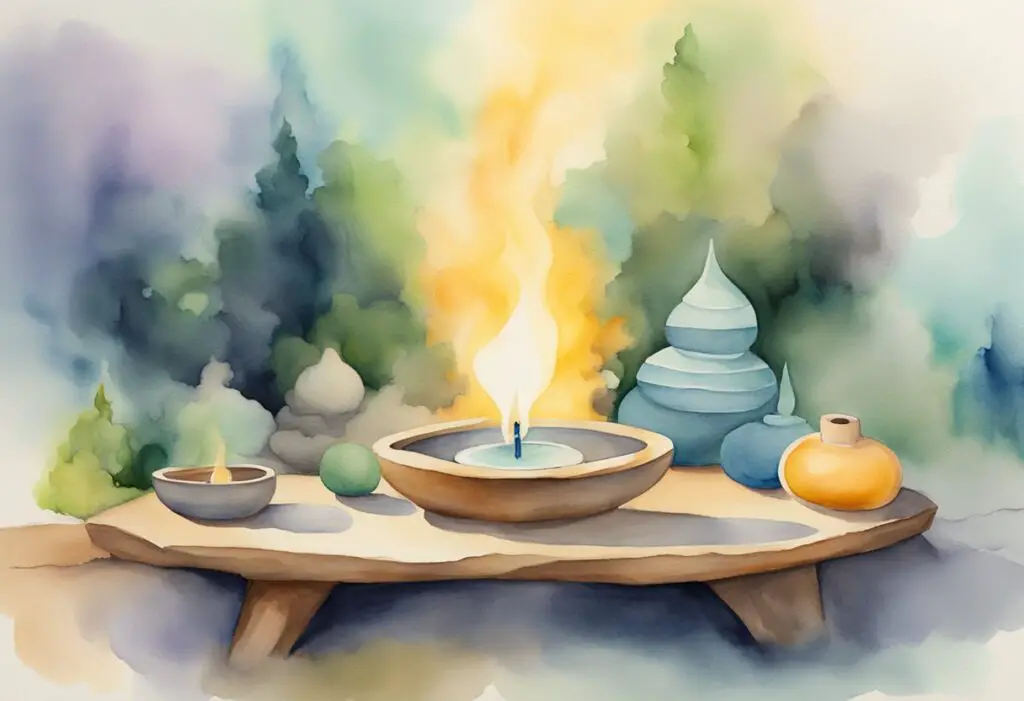The rich aromas of incense waft through spiritual spaces, creating an atmosphere that transcends the ordinary. Whether you’re lighting sandalwood for its calming influence or rose incense for emotional openness, each scent carries unique meanings that enhance your spiritual practices. Understanding the spiritual significance of different incense scents can deepen your meditation and offer protection and purification in your sacred rituals.

Imagine lighting lavender incense to foster tranquility or using frankincense to guide your spiritual growth. These scents are more than just pleasant aromas; they are tools that help you connect with your inner self and the world around you. Burning incense not only transforms the area around you but also cleanses the mind, body, and spirit, helping to focus your intentions and elevate your experience.
Incorporating incense into your daily practices can open your senses and contribute to your journey of self-awareness. From aromatherapy benefits to the spiritual meanings of incense scents, these fragrant offerings invite you to explore your spiritual path more consciously. The intention you set by burning incense can weave a tapestry of ritual that supports your well-being and enriches your life.
-

Frog Incense Stick Holder
$12.99 Add to cart -

Mahendra Incense Cones
$8.99 Select options This product has multiple variants. The options may be chosen on the product page
History and Origin of Incense in Spiritual Practices
Incense has played a crucial role in spiritual practices across various cultures. Its use spans from ancient civilizations to major religions, reflecting its significant spiritual, religious, and ceremonial value.
Ancient Civilizations and Incense
In ancient times, incense was integral to spiritual ceremonies in many cultures. The Egyptians utilized incense in rituals to connect with deities, cleanse sacred spaces, and prepare for the afterlife. Their preference for aromatic resins like frankincense reflected their belief in its divine properties. Similarly, incense was prominent in Greek and Roman practices, serving as a bridge between the human and divine, often used in offerings and to enhance meditation.
Across Asia, the Chinese employed incense for both religious and medicinal purposes. Burning incense sticks in temples became a tradition to honor ancestors and encourage spiritual mindfulness. Each culture had a unique approach, but the common thread was incense’s spiritual significance.
Incense in Christianity and Buddhism
In Christianity, incense is a symbolic element of worship. It represents prayers rising to heaven and is often used in church ceremonies, accompanying the Eucharist and other sacraments. Its biblical references highlight its long-standing religious significance. You might experience it during liturgical rituals where its aroma fills the sacred space, promoting reflection and reverence.
Buddhism, particularly in East Asia, incorporates incense in meditation and temple rituals. Incense burning accompanies chanting and offerings, and is believed to purify the surroundings and mind. It’s a tool for focus and serenity. Each stick holds a meaning, supporting worshipers in their spiritual journey and encouraging a tranquil environment that nurtures inner peace.
Types and Significance of Incense Scents
Incense scents are more than just fragrances; they carry historical and cultural significance. Different scents like sandalwood, lavender, frankincense, and myrrh are used for healing, relaxation, and rituals, each holding a unique place in spiritual practices.
Sandalwood for Healing and Protection
Sandalwood is cherished for its ability to foster healing and provide protection. Often used in meditation, it helps create a serene atmosphere by calming the mind. The scent is believed to ward off negative energy, making it a popular choice for those seeking spiritual safety.
In addition to spiritual uses, sandalwood is frequently incorporated in healing rituals due to its soothing properties.
Lavender and Chamomile for Relaxation and Calm
Lavender and chamomile are perfect for promoting relaxation and a sense of calm. The floral notes of lavender are known to reduce stress and facilitate restful sleep. When combined with chamomile, which is also renowned for its calming effects, these scents create a tranquil environment.
This combination is ideal for anyone looking to unwind and ease tension after a long day.
Frankincense and Myrrh for Purification and Rituals
Frankincense and myrrh hold a significant place in purification and ritualistic practices. Frankincense is often associated with enlightenment and spiritual growth, while myrrh has been used since ancient times for its purifying qualities. The blend of these two scents is commonly used in religious ceremonies and meditation practices to cleanse the space.
By burning these resins, you enhance spiritual experiences and invoke a deep sense of peace.
The Role of Incense in Meditation and Inner Peace

Incense can significantly enhance meditation experiences, helping you focus and achieve a sense of inner peace. By using incense, you can improve clarity, reduce stress, and promote mindfulness, creating a serene environment for your practice.
Enhancing Focus and Clarity During Meditation
Incense is known for its ability to create a calm atmosphere, allowing you to focus more deeply. Scents like sandalwood and lavender can help clear your mind, offering clarity and heightened concentration, which are essential during meditation.
Using incense sticks in a quiet space minimizes distractions, enabling you to center your thoughts more effectively. Your intention to meditate becomes stronger and clearer as the aromatic smoke envelops the room. An incense burner can serve as a focal point, drawing your attention back when your mind wanders.
Incense for Mindfulness and Stress Relief
Mindfulness involves being present in the moment, which can be helped by calming scents like opium incense. The slow burning of incense serves as a gentle reminder to stay in the present and release stress. It aids in achieving tranquility, allowing for a deeper and more profound sense of peace.
Specific scents are known for their stress-relieving properties. For example, jasmine and frankincense can create a soothing atmosphere. As the incense burns, you may find your anxiety melting away, replaced by a sense of calmness. This practice supports a mindful journey, assisting you in letting go of worries and fully embracing inner peace.
Creating Sacred Spaces with Incense
Creating a sacred atmosphere with incense can facilitate spiritual connection and awakening. Using incense, you can cleanse negative energies and establish environments conducive to meditation and reflection.
Incense for Spiritual Connection and Awakening
Incense has long been used to foster a deepening of spiritual connection. The aromas and smoke can transport you to a meditative state, enhancing your ability to meditate or pray. Certain scents, like sandalwood, are known for promoting relaxation and focus, crucial for spiritual practices.
Frankincense is another popular choice, often linked to spiritual awakening. Its distinctive scent is said to elevate your consciousness, helping you access higher states of awareness. Burning incense during your rituals can invite sacred energy into your space, encouraging deeper spiritual insights.
Benefits of Using Incense:
- Promotes calmness and focus
- Enhances meditation and prayer
- Elevates spiritual consciousness
Cleansing Negative Energies with Aromatic Smoke
Using incense to cleanse negative energies is a practice found in many cultures. The aromatic smoke is believed to purify the environment, removing any lingering negativity. For example, sandalwood is lauded for its purifying properties, often used in ceremonies to clear spaces.
Incense like lavender and sage are popular for energy cleansing. They’re known for fostering a protective barrier in your sacred spaces, promoting peace and tranquility. When you burn these incenses, visualize the smoke carrying away the negative energy, leaving behind a fresh, cleansed atmosphere.
Common Incenses for Cleansing:
- Sandalwood: Purification
- Lavender: Calmness
- Sage: Protection
Aromatic smoke can be a powerful tool in establishing a serene and spiritually cleansed space, inviting positive energy into your surroundings.
Cultural and Symbolic Meanings of Incense
In many cultures, incense plays a significant spiritual role. Understanding its symbolism and how it is used in rituals can deepen your appreciation for its spiritual significance.
Symbolism in Incense Offerings and Rituals
Incense has been used as a sacred offering in numerous religious ceremonies. When burned, the aromatic smoke is believed to carry prayers and intentions to the divine. For instance, in ancient Egyptian rituals, incense was offered to honor deities, symbolizing purity and dedication. Similarly, in Hindu ceremonies, incense is integral to puja, signifying the presence of the divine and creating a sacred atmosphere.
Jewish tradition also incorporates incense, notably in the Temple of Jerusalem, where it symbolized the anointment of sacred spaces. In Buddhism, the burning of incense during meditation and prayer represents the purification of thoughts, words, and actions. It creates a peaceful ambiance that fosters concentration and mindfulness, emphasizing the importance of incense in cultivating a spiritual connection.
Incense Smoke Patterns and Spiritual Insights
The patterns formed by incense smoke are often interpreted as spiritual symbols. Observing how the smoke ascends, swirls, or disperses can provide insights into divine messages and spiritual energy. In some cultures, a straight smoke trail is seen as an indication of alignment with spiritual purposes, suggesting clarity and strength in communication with the spiritual realm.
Missteps or unexpected changes in the smoke pattern might symbolize interference, prompting reflection and realignment. In Indigenous practices, smoke patterns are closely watched during rituals, offering guidance and insight into the spiritual dimensions at play. These interpretations encourage mindfulness and open your awareness to subtle spiritual cues, enhancing your ceremonial experience and understanding of the universe’s spiritual tapestry.

